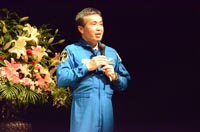Astronaut Kimiya Yui undergoes training for a long-duration ISS mission in Russia and Japan
Astronaut Kimiya Yui, a crew member for the ISS expedition 44/45 mission, underwent training at the Gagarin Cosmonaut Training Center (GCTC) in the first half of August. In the second half of the month, Yui temporarily returned to Japan to train at the Tsukuba Space Center (TKSC).
In Russia, training was held for the Soyuz spacecraft and the ISS Russian segment. Using a simulator to recreate the Soyuz spacecraft, Yui rehearsed operations from launch to docking, with the time involved similar to those of actual operations. He also simulated manual atmospheric re-entry operations in preparation for the possible failure of the automated control mode.
As part of the Russian segment training, Yui operated the Inventory Management System (IMS) installed in the computer and took an exam on the segment’s internal hardware layout. Assuming sudden depressurization in the mock-up Russian module located in the decompression chamber, he experienced operations with the hatch, which became difficult to open and close due to pressure difference.
An emergency return from the ISS was also simulated, which involved Yui undergoing the entire process - boarding the Soyuz spacecraft, undocking from the ISS, responding to various failures, and landing on Earth.
During his stay in Russia, Yui also visited “Zvezda”, the manufacturer of Sokol spacesuits, for a fitting of the spacesuit to be worn during the Soyuz flight. He checked his Sokol space suit, to see whether it would fit his custom-made Soyuz seat liner and whether it would function properly under a low-pressure environment.
Yui also visited RSC Energia, the Soyuz spacecraft developer and had the chance to check out the real spacecraft; not normally accessible during everyday training.
At the TKSC, he was trained in the systems of the Japanese Experiment Module, “Kibo” and Japanese experiments.
He reviewed what he had learned in the previous training series as well as learning how to operate and maintain the Proximity Communication System (PROX), the system used when the H-II Transfer Vehicle (HTV) KOUNOTORI approaches the station, Kibo's airlock, and the TV cameras.
The training included Kibo's robotic arm (Japanese Experiment Module Remote Manipulator System: JEMRMS) operating alongside the JAXA Flight Control Team (JFCT).
Yui simulated the JEMRMS operation in cooperation with the JFCT; including both nominal and failure operations. As such, he experienced the task sequence unfolding by collaborating with ground staff. Training for the experiments onboard Kibo included an overview of the experimental themes and equipment involved.

